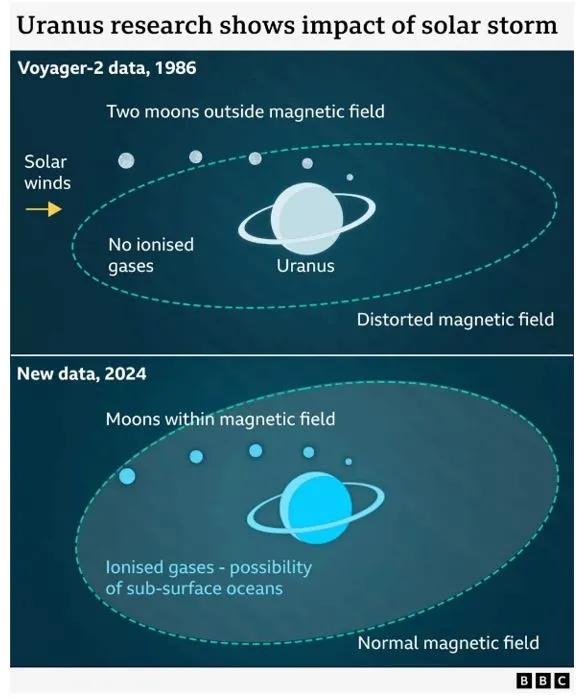

13th November 2024 (9 Topics)
Context
Uranus has long been a subject of curiosity. Despite being a gas giant, it remains one of the least explored planets. The only spacecraft to visit it was NASA's Voyager 2, which flew past Uranus in 1986. However, new research suggests that the data collected by Voyager 2 might have been skewed due to unusual conditions during the flyby.
Key Findings of the Study
- This recent study published in the journal Nature Astronomychallenges the previous findings, suggesting that our understanding of Uranus, particularly its magnetosphere and moon activity, might need to be revisited.
- Voyager 2’s Flyby and Solar Wind Effects
- Voyager 2’s Flyby: In 1986, Voyager 2 passed by Uranus at a distance of about 81,500 km. During this pass, the spacecraft observed the planet’s magnetosphere, the protective magnetic field around Uranus.
- Effect of Solar Wind: However, during this flyby, Uranus was affected by a powerful solar wind, which caused significant changes to its magnetosphere. This weakened its typical properties, making it look quite different from the magnetospheres of other gas giants like Jupiter and Saturn.
- Impact on Findings: Scientists believe that if the spacecraft had passed a week earlier or later, the data could have shown a very different picture of Uranus' magnetic field.
- Magnetosphere of Uranus: New Insights
- Asymmetry and Radiation: Uranus' magnetosphere is highly asymmetricand has intense radiation belts. Unlike other gas giants, Uranus has a unique magnetic field that scientists are still trying to understand fully.
- Revised Understanding: The findings suggest that Voyager 2 might not have captured the true nature of Uranus' magnetic field due to the specific timing of its flyby.
- Implications for Uranus’ Moons
- Moons of Uranus: Uranus has five major moons, and they were previously thought to be geologically inactive. The lack of plasma (charged particles) in Voyager 2's data was once seen as an indication that the planet was in a state of "quiescence" (calm and inactive).
- New Possibilities: However, new analysis suggests that Uranus' moons might not be as inactive as once believed. There is now speculation that some of the moons could be geologically active, meaning they may have ongoing internal processes like volcanoes or tectonic activity.

Fact Box: Uranus
|

